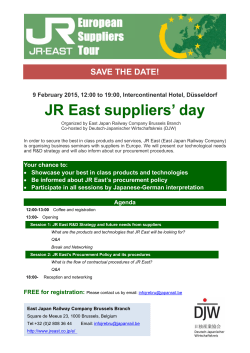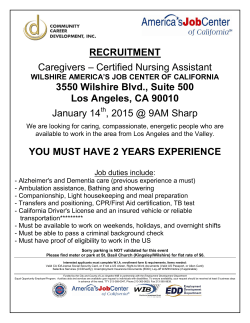
Building Canada Fund Application Additional
Building Canada Fund Application Additional Information on the Projects Council Seminar March 24, 2015 Presentation outline Background Transportation Master Plan (TMP) Priorities Rationale Rationale for the 4 projects selected Prioritized list of the 4 projects based on the Investment Planning process Recommended project priority Background The City has submitted applications proposing four projects for funding from the New Building Canada Fund. A. B. C. D. Marion Street Re-alignment and Underpass, $250 million Waverley Underpass, $175 million Chief Peguis Trail Extension West, $400 million Kenaston Widening, $375 million The Province recently requested the City to identify the four projects in order of priority for funding. Project costs estimates are preliminary and are considered Class 5. Transportation Master Plan Rationale for the Priorities Prioritization Methodology used in Transportation Master Plan Four land use scenarios were analyzed to determine deficiencies in the transportation network and when improvements to that network were most likely needed over the short (by 2016), medium (by 2021) and long terms (by 2031) PlanWinnipeg: Business as usual growth, based on current development applications, using agricultural-designated land for residential development OurWinnipeg Adoption: low density development in New Communities and some development in transformative areas OurWinnipeg Adoption and Implementation: increased density in New Communities, Transit Oriented Development OurWinnipeg Adoption and Focused Implementation: multifamily development in downtown, in mixed-used centres and corridors and major redevelopment sites Prioritization Methodology used in Transportation Master Plan The analysis also included the benefits and implications of completing all five of the Rapid Transit corridors identified in OurWinnipeg The Roadwork Implementation as detailed in the Transportation Master Plan (TMP) was developed through the use of TransCAD, a state of the art travel demand model that uses current and projected traffic volumes integrated with origins and destinations of road users based on land use Prioritization Methodology used in Transportation Master Plan Grouping instead of ranking of recommendations – Makes the recommendations resilient to time and avoids relying on a ranking of projects developed under conditions that may not reflect current conditions – Short (2016) term: reflects the 5 year Capital Budget at time of adoption of the TMP – Medium (2021) term: half way through the horizon – Long (2031) term: horizon based on the Conference Board of Canada housing and population forecast Prioritization Methodology used in Transportation Master Plan Council changes to TMP: TMP Adopted on November 16, 2011 with these changes: – – – TMP modified by Council on April 25, 2012: – – – A strategic goal related to gas emissions was added The Southwest & East rapid transit corridor were moved to the short term timeframe The Marion-Goulet Connection was renamed Chief Peguis Trail Extension from Main Street to McPhillips Street was moved to the short term Chief Peguis Trail Extension from McPhillips Street to Route 90 was moved to the short term William R. Clement Parkway from Grant Avenue to Wilkes Avenue was moved to the short term TMP modified by Council on March 20, 2013: – The alignment of the second phase of the Southwest Rapid Transit Corridor extends westward through the Parker Lands and southeastward along the Manitoba Hydro Corridor D A Transportation Master Plan C2 C1 C1 A D B B C2 Project moved up Completed or underway Rationale for how the 4 projects were selected On June 25 2014 Council adopted 6 projects for inter-governmental funding: – Waverley Street Underpass – Marion Street Widening/Grade Separation and Improvements from Archibald Street to Lagimodiere Boulevard – Chief Peguis Trail Extension from Main Street to Route 90 – Louise Bridge Replacement* – William R. Clement Parkway Extension from Grant Avenue to Wilkes Avenue* – Widening of Kenaston Boulevard (Route 90) from Ness Avenue to Taylor Avenue *2 projects are not ready to move forward as the scope has not been defined (no functional study) Investment Selection using the Investment Planning Process For the 2015 Capital budget, projects were required to follow the Asset Management Investment Planning process which reflects the Council adopted Asset Management Policy “Consistently deliver established customer service levels at an acceptable level of risk while minimizing an asset’s lifecycle costs” Rationale for the four projects selected Investment Planning Process Investment Planning Framework Goals Clearly Defined LOS Needs Solutions Priority Long-term affordability of Service Plan Asset Management Plans Strategic Planning Robust approach to identifying legislative, efficiency improvements & growth to LOS Existing Assets Business Case Evaluation Risk Based approach to maintain LOS Short-term impact to Service Project Prioritization & Selection Capital Budget (1-3 year) Robust Investment Plans Customer Service Targets Investment Service target gaps Kenaston Widening • • • • 50,000 vehicles per day Sustained deficiency in LOS beyond peak periods Economic development route with significant regional impact High frequency of collisions Marion Street Re-alignment and Underpass • • • • • • 35,000 vehicles per day Deficiency in LOS during peak periods New legislation for railway crossing Approximately 4-8 trains per day Active transportation accommodation Economic development route with minor regional impact Waverley Underpass • • • • • 30,000 vehicles per day Deficiency in LOS during peak periods Meet new legislation for railway crossing Approximately 40 trains per day Latent demand from Waverley West Chief Peguis Trail Extension West • • • Estimated 12,000-20,000 vehicles per day may use this road Active Transportation accommodation Connection to CentrePort & provides access to future development in New Communities Investment Cost/Benefit Investments are scored against a common set of Benefit criteria Lower C/B ratio means project yields higher economic benefit Benefit Criteria Category Criteria This project: Examples Weight Maintain Service Maintaining Essential LOS maintains the aspects of service as set down in existing legislation/regulation or with regard to public health Safety of Public; HTA Compliance; Drinking Water 26% Maintain Service Maintaining Quality LOS maintains the aspects of service as directed by current City Policies, Strategies etc Maintains average time between bus service; provide recreation services 13% Maintain Service Maintaining Aesthetic LOS Maintains aesthetic aspects of a service Condition of existing streetscaping 6% Enhance Service Enhancing Quality LOS enhances the aspects of service as directed by new City Policies, Strategies etc Reduce travel time between points; reduce basement flooding incidents 4% Enhance Service Enhancing Aesthetic LOS enhances aesthetic aspects of a service New streetscaping; new decorative landscaping 1% Regulatory Regulatory Changes (Incl H&S, Enviro) makes changes to the service to meet new regulatory requirements New nutrient removal in wastewater; install new safety equipment 26% Environmental Enviro/Sustainability Improvement (Voluntary) makes changes to the service to improve environmental/sustainability aspects Reduce greenhouse gases; support active transportation 3% Growth Promoting the Economy/Enabling Growth of City either supports business development or enables growth of City Widening/extending major route; extend water supply to new development 12% Savings Operational Efficiency replaces existing infrastructure to improve operational efficiency (spend to save) Replace old pumps with new to improve performance and reduce electrical use 7% Culture Promoting Culture and Heritage preserves and/or protects historic sites; maintains/creates performance venues Develop stage in Wascana Park 2% Investment Cost/Benefit Investment C/B score* Waverley Underpass 11 • Waverley West and development in south Winnipeg has created a large demand for mobility on Waverley St. • This is the railway at-grade crossing with the highest warrant in the city. • New legislation is in place pertaining to railway crossings • Injury outcome of collisions with trains is almost certain • Work on this project can have mobility impacts to a large proportion of the City if going ahead at the same time as Kenaston Widening and CIP Kenaston Widening 32 • The St. James bridge requires imminent work in the next 5 years • This route impacts economic development city-wide • This project may be done in two phases, with the first being from Ness to Tuxedo in conjunction with bridge works • This project will increase AT network coverage *Lowest score indicates higher economic benefits Investment Cost/Benefit Investment C/B score* Marion Street Realignment and Underpass 53 Chief Peguis Trail Extension West 496 *Lowest score indicates higher economic benefits • This is a major route to the east of Winnipeg from downtown • There is a potential for significant development west of Lagimodiere Blvd. • New legislation is in place pertaining to railway crossings • The injury outcome of collision with trains is almost certain • This project will increase AT network coverage • Approx. 140 property owners • • • • • • Provides access to future demand to CentrePort Supports future growth in New Communities The need for this facility is not imminent This project will increase AT network coverage Likely to attract traffic from PTH 101 (Perimeter Hwy) This project may be done in two phases with the first being from Main to McPhillips Residual Risk Assessment Investment Planning Process Residual Risk Assessment The purpose of the residual risk assessment is to quantify the impact of delaying the investment A risk event(s) is identified based on the investment being delayed For each risk event a mitigation action is determined, together with the cost associated with each action Higher risk means that there are more negative impacts associated with delaying the project Residual Risk Assessment Investment Residual Risk events Risk Mitigation Strategy (if the Investment was delayed) Chief Peguis Trail Extension West Marion Street Realignment and Underpass • Meeting future demand – i.e. servicing CentrePort & Future development of New Communities • Traffic flows not meeting service targets in the future • Asset condition - ability to meet minimal service levels • Safety due to railway and roadway configuration Impact (cost associated with delay2015 dollars) • No impact based on CentrePort’s growth and development staging • Demand in the transportation system is not expected in the immediate future • Improve traffic control (signal timing) • Signals: $15k/yr • Continue overlays, maintenance spending • Bridge inspections and maintenance • Road: $500k within 3 yrs • Railway crossing improvement • Improvements to traffic control (marginal service improvements expected) • Rail: $25k/yr • Signals: $10k/yr • Bridge: $10k/yr Residual Risk Assessment Investment Residual Risk events Risk Mitigation Strategy (if the Impact (cost associated with delay2015 dollars) Investment was delayed) Waverley Underpass Kenaston Widening • Asset condition - ability to meet minimal service • Continue overlays, maintenance spending • Road: every 3 yrs $300k • Safety due to railway and roadway configuration (Train – vehicle – pedestrian collisions • Railway crossing improvement, add gates at pedestrian crossing • Rail: every 3 yrs $50k • Rail Gates : $50k-150k • Traffic flows not meeting service targets • Improvements to traffic control (marginal service improvements expected) • Signals: $10k/yr • Asset condition - ability to meet minimal service • Continue overlays • Road: $100k/yr • Traffic flows not meeting service targets • Improvements to traffic control (marginal service improvements expected) • Signals: $35k/yr • Bridge rehab NB and replace SB (Bridge investment is required, no further mitigation action possible) • - • Vehicle collisions due to road configuration • Bridge investment can not be delayed Bridge: $3.2M prelim design 2017 $2.1M detailed design 2019 $130M ($70M for SB by 2020 & $60M for NB by 2023) Recommended Project Priority Order of Priority Investment Priority Investment 1 C/B 11 Third Highest Risk Waverley Underpass 2 C/B 32 Highest Risk 3 C/B 53 Second Highest Risk 4 C/B 496 Lowest Risk Kenaston Widening Rationale • New safety legislation is in place pertaining to railway crossings • This is the railway crossing with the highest warrant in the city • Waverley West and development in south Winnipeg has created a large demand for mobility on Waverley St. • • • • The St. James bridge requires imminent work There is a deficiency in LOS at this time This route impacts economic development Roadway requires reconstruction Marion Street Re-alignment and Underpass • New safety legislation is in place pertaining to railway crossings • This is a major route to the east of Winnipeg from downtown • There is a potentially for significant development west of Lagimodiere Blvd. Chief Peguis Trail Extension West • • • • Connects with CentrePort Not needed now but supports future growth High Capital cost Attracts users using Perimeter Hwy. Debt Limit and Affordability Must also consider the amount of debt, debt repayment, a funding source, and affordability. Capital Costs / Debt $ in millions Kenaston Peguis Trail Marion Waverley Clement Parkway Louise Bridge Roads subtotal total cost $375 $400 $250 $175 $125 $150 $1,475 City share % City (debt) share $142 38% $150 38% $110 44% $64 37% $50 40% $60 40% $576 Annual Payments Affordability Borrowing additional Costs operational/ Total City annual maintenance Annual payments annual costs Payments $10.1 $1.9 $12.0 $10.7 $2.0 $12.7 $7.9 $1.3 $9.1 $4.6 $0.9 $5.4 $3.6 $0.6 $4.2 $4.3 $0.8 $5.0 $41.1 $7.4 $48.5 Operating Budget Impact Equivalent Property Tax Increase 2.4% 2.5% 1.8% 1.1% 0.8% 1.0% 9.7% This analysis is for planning purposes only Some costs have not been determined -- Order of magnitude used for analysis purposes, 2017 dollars, Class 5 costs Assume City funds projects using debt
© Copyright 2025









